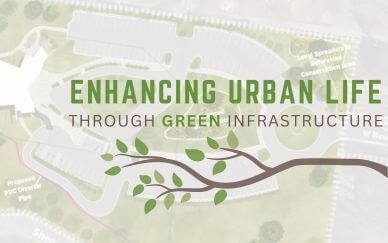In the face of rapid urbanization and environmental challenges, communities around the world are increasingly turning to green infrastructure as a solution to improve their communities. Green infrastructure refers to a network of natural and semi-natural solutions that provide a wide range of environmental, social, and economic benefits. This approach contrasts with traditional infrastructure—such as asphalt parking lots and pipes—by integrating nature-based infrastructure into urban planning. Here, we explore how green infrastructure transforms public outdoor spaces and the benefits it offers.
Environmental Benefits
Improved Air Quality
Green infrastructure, including urban forests, green roofs, and green walls, helps filter pollutants from the air. Trees and plants absorb carbon dioxide and release oxygen, reducing greenhouse gases and improving air quality.
Enhanced Water Management
Green infrastructure techniques, such as permeable pavement and rain gardens, manage stormwater more effectively than traditional systems. They reduce runoff, decrease the risk of flooding, and help recharge groundwater supplies. This is particularly crucial in urban areas where impermeable surfaces dominate, leading to increased flood risks and water pollution.
Biodiversity Support
By incorporating green spaces like parks, community gardens, and green corridors into urban planning, cities and towns can provide habitats for various species. Green spaces support biodiversity, help maintain ecological balance, and can even support local food systems.
Social Benefits
Improved Public Health
Access to green space is associated with numerous health benefits. Green infrastructure provides spaces for physical activity, relaxation, and social interaction, which can reduce stress, improve mental health, and promote overall well-being. Studies show that urban green spaces can lead to lower rates of obesity, cardiovascular disease, and mental health disorders.
Enhanced Community Cohesion
Green infrastructure fosters community engagement by creating spaces for social interaction and recreational activities. Community gardens, parks, and green streets encourage social gatherings and strengthen community ties. They can also serve as venues for educational and cultural activities, enhancing community cohesion.
Increased Property Values
Properties near well-maintained green spaces often see an increase in value. The aesthetic and environmental appeal of green infrastructure can make neighborhoods more attractive to potential buyers. This increase in property values can boost local economies and generate additional revenue for municipalities.
Economic Benefits
Cost Savings
Investing in green infrastructure can lead to long-term cost savings. For example, green roofs and walls can reduce heating and cooling costs by providing natural insulation in residential and commercial settings. Additionally, green infrastructure reduces the need for expensive gray infrastructure maintenance and repairs by mitigating issues like flooding and erosion.
Job Creation
The development and maintenance of green infrastructure create employment opportunities in fields such as landscaping, horticulture, and urban planning. Green projects can stimulate local economies and provide jobs for community members, contributing to economic growth.
Tourism and Business Attraction
Well-designed green spaces can attract tourists and new businesses. Vibrant parks, scenic greenways, and eco-friendly developments draw visitors and can boost local businesses. Cities known for their green infrastructure often become desirable destinations for both tourists and potential residents.
Downstream Strategies is committed to helping communities go green. From our green space and trail planning services to our collaborative efforts developing green-collar workforces, we understand the importance and future of green infrastructure in community planning. For more information about how we can help your community go green, contact us at info@downstreamstrategies.com.

